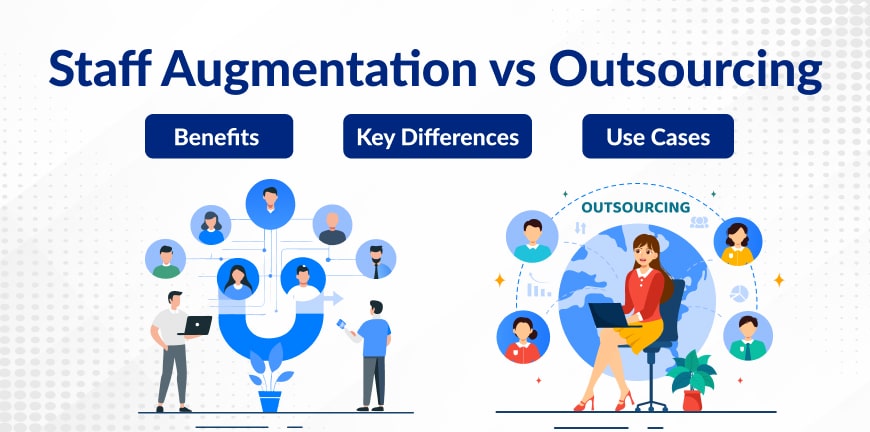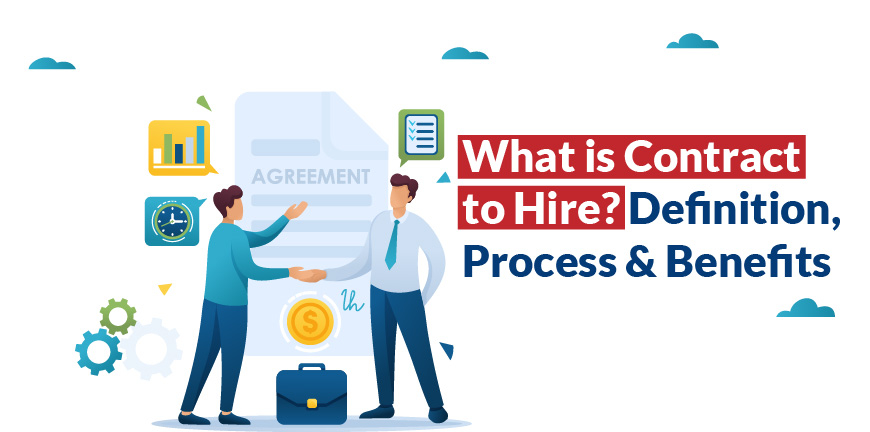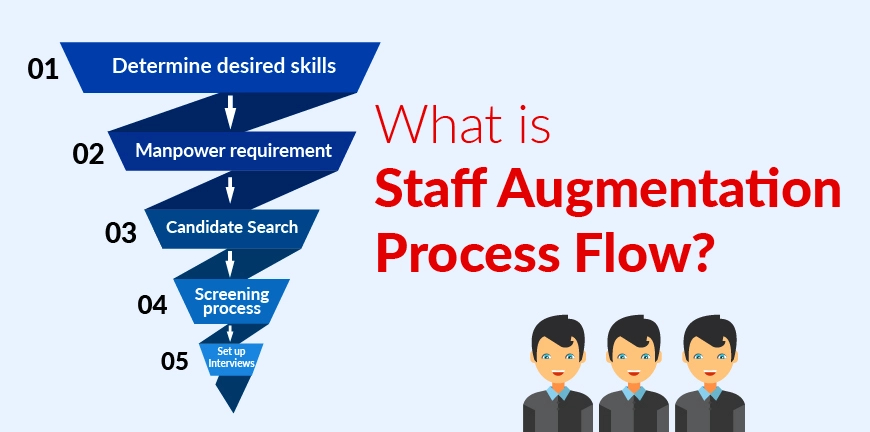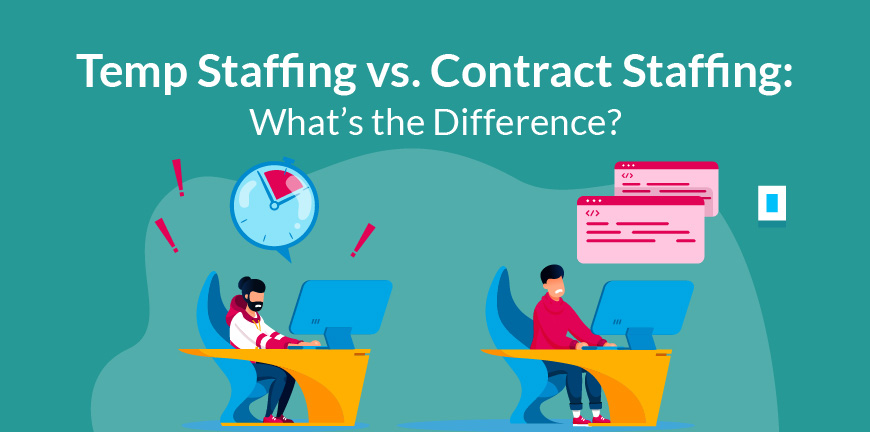
What Is Professional Tax in Compliance? Challenges & Best Practices
07/05/2025
What is a Talent Pool? Types, Importance & How to Build One?
07/05/2025- Introduction
- What is Staff Augmentation?
- What is Outsourcing?
- Staff Augmentation vs Outsourcing: Key Differences
- What are the Key Differences Between Staff Augmentation and Outsourcing?
- What are the pros and Cons of Staff Augmentation?
- What are the Pros and Cons of Outsourcing?
- When to Choose Staff Augmentation?
- When to Choose Outsourcing?
- Frequently Asked Questions (FAQs)
Introduction
Staff augmentation Vs outsourcing, two impactful workforce models enabling businesses to stay agile, fill talent gaps, and cater to project demands, being hassle-free of long-term hiring. Staff augmentation hires skilled professionals directly into your in-house team for hands-on collaboration, while outsourcing delegates entire projects or operations to external experts.
The perfect blend of flexibility and scalability is a combined effort of these two strategies, whether you need extra assistance or a full-service team to complete the job.
What is Staff Augmentation?
Staff augmentation refers to a hiring strategy where organizations recruit skilled professionals temporarily through a third-party agency that becomes a part of their in-house teams to cater to specific project needs or fill talent gaps. Staff augmentation allows businesses to scale up and down their workforce, maintain project control, and adjust to changing business requirements without the full-time hiring commitment.
What is Outsourcing?
Outsourcing is a hiring model where a company hands over specific tasks, projects, or entire business operations to an external agency, not letting the in-house team get involved. Outsourcing meaning is related to enabling businesses to enhance efficiency, alleviate costs, and scale the workforce quickly by delegating resource-intensive operations to external teams.
Staff Augmentation vs Outsourcing: Key Differences
Staff augmentation Vs Outsourcing. The two recruitment strategies are used by businesses to cater to their business requirements for additional skills or resources. It is essential for businesses to comprehend the difference between these models for making informed decisions that cater to an organization’s goals and operational dynamics. Let us dive into the differences between these two strategies:
1. Cost Implications
A staff augmentation strategy entails costs related to the salary of the augmented staff and of the staffing agency. This approach can be cost-effective for short-term projects, as it does not include the long-term costs associated with recruiting hires for long-term purposes and full-time employees with benefits, training, and equipment. Meanwhile, the approach of outsourcing can also lead to significant cost savings, especially when tasks are outsourced to third parties whose labour costs are low.
However, there can be additional costs associated with the efforts of the management, quality control concerns, and other risks related to dependency on an external agency.
2. Control and Management
Staff augmentation enables businesses to take full charge of an organization’s projects and the augmented staff member as they work within their preview and operational structures.
This strategy lets companies directly manage and monitor the work quality that aligns with their business culture and processes. Meanwhile, an outsourcing arrangement allows the external agency to take responsibility for managing the outsourced function or project.
This leads to the company losing total control over day-to-day operations, resulting in work environment differences and unpleasantness.
3. Flexibility and Scalability
As market situations keep fluctuating, implementing a strategy like Staff augmentation allows businesses to easily adjust the number of augmented staff members as per project requirements, leading to scaling up or down as needed. The adaptability allows businesses to respond swiftly to evolving market conditions.
Meanwhile, outsourcing may have restricted flexibility as contracts and service agreements often include fixed terms and conditions, and it becomes a challenge for businesses to make adjustments instantly. Ensure scalability, organizations might have to take a different approach in terms of negotiating agreements or consider additional service providers.
4. Quality and Expertise
Augmented staff members are typically skilled professionals specialized in a particular domain, who help businesses in providing in-depth expertise and innovative ideas for specific projects. This can accelerate the quality of work and drive better outcomes if their skills are effectively integrated with your team’s efforts.
Although the outsourced team members are also specialists in their respective areas, offering a top-quality expertise, however, to match the work quality with an organisation’s standards might need clarity in specifications, ongoing transparent communication, and focused governance.
What are the Key Differences Between Staff Augmentation and Outsourcing?
| Features | Staff Augmentation | Outsourcing |
| Team Control | Managed by your internal team | Managed by the external vendor |
| Team Integration | External staff become part of your in-house team | The external team works independently |
| Scope | Specific roles or skill sets | Entire projects or business processes |
| Cost Model | Pay per resource/hour | Pay per project or service agreement |
| Flexibility | High—scale up or down as needed | Moderate — usually contract-based and scope-driven |
| Risk Management | You assume delivery responsibility | Vendor assumes delivery responsibility |
What are the pros and Cons of Staff Augmentation?
To adapt to changing market dynamics easily and effortlessly, the adoption of a model like Staff Augmentation is essential. Let us look at a few of the staff augmentation benefits:
1. Enhanced Scalability
In today’s ever-evolving business landscape, companies should be able to adapt quickly to stay ahead of the curve. Staff augmentation allows for the kind of flexibility to react to shifting market requirements.
Whether it is unexpected project needs or a sudden spike in workload, this model helps businesses to adjust without hampering the existing internal and external resources.
If a project requires change due to seasonal demand drop, organizations can easily downsize the workforce without putting strain on the financial and logistical aspects. The method handles the workload fluctuations, allowing the internal team to focus on the core strategic work driving business growth.
2. Specialized Skill
By implementing the Staff augmentation strategy, businesses can tap into a global and diverse talent pool of talent, including niche specialists and highly experienced professionals. The model offers a slew of experts in the domains of Bring in experts in emerging technologies like AI, blockchain, and advanced analytics to drive a new product development or accelerate an organization’s innovation effort.
A Few industries or projects might require expertise not always available in local markets. Staff augmentation will provide you access to the best quality across the globe, regardless of geographical boundaries.
3. Cost Effectiveness
One of the most important advantages of staff augmentation is that it is highly cost-effective. It enables a business to optimize operational budget and attain financial agility by introducing flexibility into the staffing model.
An organization only pays for specific skills and expertise required for a specific period. This obliterates the costs associated with full-time employees, like salaries, benefits, onboarding expenses, and office space.
Eliminating the traditional, lengthy, and expensive process, this model helps companies identify the right talent effectively and efficiently, saving time and money.
4. Risk Mitigation
Staff augmentation is a strategy that helps in diminishing the risks related to bad hires and overstaffing. Long-term obligations can be minimised with contract or project-based work. This approach significantly reduces risk as the engagement is for short-term projects or tasks, and individuals are vetted by the staffing agency.
If they feel that a professional is not fit for the job, then a replacement can be quickly requested without the complicated and lengthy HR and legal procedures like those of permanent employment.
Businesses mostly face obstruction when it comes to presenting their staffing requirements accurately. This ends up in over-hiring, leading to high labour costs, meanwhile understaffing might delay project delivery.
Staff augmentation is one of the best solutions where skilled professionals with specific expertise are brought in during peak season, for tight deadlines, or for specific projects.
Staff augmentation is a flexible approach offering flexibility and access to a wide talent pool; however, it comes with potential drawbacks. Let us check out some of the disadvantages:
5. Lack of Commitment
The professionals hired through staff augmentation are essentially recruited for short-term projects or on a contract basis, so their main focus is to complete the specific task assigned to them. They are often not interested in participating in the long-term affairs of a company and do not contribute to the growth or the vision. The existing ad core staff of the organizations may treat them as outsiders, resulting in a divide that might adversely affect communication and collaboration.
6. Integration Challenges
In every organization, there are unique rules, culture, and values. It sometimes becomes difficult for external hires to understand the internal behavioural patterns, decision-making, hierarchy, or to embrace the tone of communication.
There is always a disconnect that might lead to misunderstandings or unprofessionalism, even if the augmented staff is skilled. In such cases, seamless integration into the process can be a hurdle. There might also be a risk of project delays. Inefficiency and quality issues.
7. Knowledge Transfer Issues
Staff augmentation is an effective approach for speed and flexibility, but it can cause valuable knowledge loss when the augmented staff members exit. If the documentation and handover process are flawed, potential knowledge does not get transferred smoothly.
The primary focus of augmented staff is executing tasks, not building long-term relationships or imparting their knowledge for company growth. They are not a part of the permanent team, hence they do not feel responsible for maintaining knowledge continuity or training other members.
8. Reliance on an External Party
As organizations become too dependent on third-party staff agencies, they lose a degree of control over the augmented staff, which involves how candidates are screened and control over the quality and consistency of talent delivered.
Third-party agencies focus on meeting client expectations, and organizations are fully reliant on them, which might lead to a slew of risks and inefficiencies if not carefully mitigated and controlled.
Trusting providers with the assessment of qualifications, experience, cultural fit, and professionalism might lead to inconsistencies as their criteria may not cater to a company’s internal standards.
9. Security and Confidentiality Risk
Organizations, with the help of third-party providers, bring in temporary or augmented staff who typically work on projects that entail confidential information, proprietary systems, or customer data. This might lead to an increased risk of data breaches, IP theft, or non-compliance, especially if security protocols are not in place. Temporary or contractors are usually not a part of the company’s core, stringent security, privacy, and compliance frameworks and could prove as weak links in an otherwise secure work landscape.
What are the Pros and Cons of Outsourcing?
Outsourcing meaning is properly defined when organisations utilize this common practice of outsourcing business operations and processes to third-party agencies. Let us have a look at some of the benefits:
1. Cost Efficiency
Organizations typically delegate services to third-party providers by adopting the approach of outsourcing. The providers could be in areas where the labour cost and business operation costs are significantly lower. A company in this way can save substantially across multiple regions, keeping the delivery of core services intact.
2. Access to Global Talent
Organizations receive a strategic advantage by adopting outsourcing as a recruitment approach, as they get connected with highly skilled professionals and individuals with domain expertise from across the globe. These experts may not be readily available and can be expensive to hire from a company’s local talent pool. Outsourcing transcends local hiring, enabling companies to tap into a global pool of workforce.
3. Scalability and Flexibility
One of the strongest benefits of outsourcing is that it enables companies to scale resources up or down as per the fluctuating business requirements. This flexibility is not possible when it comes to traditional, in-house recruitment, as it involves time, costs, and employment regulations.
Outsourcing allows businesses to add new team members immediately to meet the needs without undergoing a lengthy process, as the provider already has a ready talent pool.
4. Faster, Efficient Outcomes
Outsourcing partners already possess established workflows, experienced teams, and industry-specific tools, driving them to help businesses more efficiently than an internal team that would have to start from scratch. The operational readiness with the necessary tools can significantly reduce time-to-market and can be helpful to organizations launching new projects, venturing into new markets, or going through digital transformation.
With advantages come challenges as well. So let us check out some of the disadvantages of outsourcing:
5. Loss of Control
With speed and flexibility, outsourcing strategies also bring in a physical and operational distance between an organization and the team assigned for their work. It becomes a problem to meet quality standards, timelines, and objectives, reducing oversight. Teams that are remote and managed by third-party agencies cannot be closely monitored by organizations, and it becomes difficult for them to track activities, real-time progress, or intervene instantly when issues arise.
6. Communication Issues
Outsourcing can enable access to global talent for companies; however, it can also introduce a range of challenges, including cross-cultural, linguistic, and logistical hurdles. This could significantly disrupt effective collaboration. Ill-managed issues can lead to constant delay, misunderstandings, poor work quality, adversely impacting timelines, morale, and the success of a project.
7. Quality Concerns
As a team is managed by third-party vendors in outsourcing, one of the most common concerns is that the quality of deliverables is impacted and may not meet expectations consistently. During a sales process, a vendor might make promises, but not all providers might maintain and deliver the same standard. So, it is essential to have clear oversight, accountability measures, or accurate service agreements.
8. Data Security and Privacy
There is an increasing risk of unauthorized access, data leaks, or regulatory non-compliance when organisations decide to outsource services. Especially when it comes to technical or customer-facing operations, they often have to share access to sensitive data, systems, or intellectual property (IP) with external parties. This enhances the risk of data breaches affecting the reputation and functioning of a business.
When to Choose Staff Augmentation?
It is ideal to choose staff augmentation in specific business cases where flexibility, speed, and the requirement of specialized talent are vital than long-term commitments. If an organization is seeking to fill gaps and lacks technical expertise can temporarily bring in specialized talent.
Staff augmentation is also effective for companies that suddenly need to scale up without overburdening the core team when there is a surge in workload. This approach also helps organizations when they face financial constraints by controlling costs like avoiding permanent salaries, benefits, and long-term overhead.
There could be economic downturns and fluctuating market scenarios, and this is where staff augmentation can help by its flexibility, enabling companies to scale up and down accordingly.
When to Choose Outsourcing?
Outsourcing is a process that enables organizations to focus on core competencies, having offloaded the other responsibilities to a third-party vendor. This approach helps companies to save on expenses by providing them access to a lower-cost labour market or shared service models.
This can eliminate expenses associated with hiring, training, office space, and employee benefits. Outsourcing is a very efficient and flexible approach that enables businesses to scale up and down their operations as per requirements. especially in uncertain or fast-evolving environments.
Key Takeaways:
- Staff augmentation integrates skilled professionals into a team temporarily, offering flexibility, control, and specialized talent.
- Outsourcing assigns entire functions or projects to external vendors, enabling cost savings, efficiency.
- Staff augmentation ensures project control and team integration, while outsourcing may reduce oversight.
- Both models offer scalability, with staff augmentation being more agile
- Both models comprise security risks and integration challenges requiring clear communication
Frequently Asked Questions (FAQs)
1. What is the difference between outsourcing and augmentation?
Outsourcing and augmentation are approaches to add resources from outside. While outsourcing is an approach where companies outsource the hiring process to an external party while augmentation is where organizations recruit temporary staff member as per their needs to directly work with their team.
2. What is the difference between outsourcing and staffing?
While outsourcing is an HR strategy where organizations contract with an external agency to manage specific projects or processes, the agency might take full responsibility for the task. Staffing, on the other hand, is where businesses manage and control the workforce and operations themselves, like hiring, training, etc.
3. What does staff augmentation mean?
Staff augmentation is a hiring strategy where organizations recruit specialized talent to be a part of their existing workforce to cater to specific projects or sometimes address a skill gap. This model adds talent without any commitment to hiring full-time employees.
4. Which is more cost-effective, staff augmentation or outsourcing?
Both staff augmentation and outsourcing are cost-effective. Outsourcing becomes more cost-effective than outsourcing when it comes to specific tasks or projects that can offer reduced labour costs and low overhead expenditures. This method can let organizations access expertise, doing away with the hiring and training burden.
5. What are the 4 types of outsourcing?
The 4 categories of outsourcing entail Business Process Outsourcing (BPO), IT Outsourcing, Project Outsourcing, and Professional Outsourcing. These categories offer an array of services from administrative task handling to managing complex projects and systems.
Contact Us For Business Enquiry

Kasthuri R
Kasthuri R is the Co-Founder & Executive Director at ALP Consulting, bringing over 23 years of experience in search, staffing, and HR consulting. She has been instrumental in driving ALP’s recruitment, employee leasing, and executive search practices across diverse industry verticals. With deep expertise in talent acquisition, HR strategy, and operational management, Kasthuri has built scalable, client-focused solutions that enhance workforce efficiency. Her strategic leadership continues to steer ALP Consulting toward innovation and excellence in people management.




